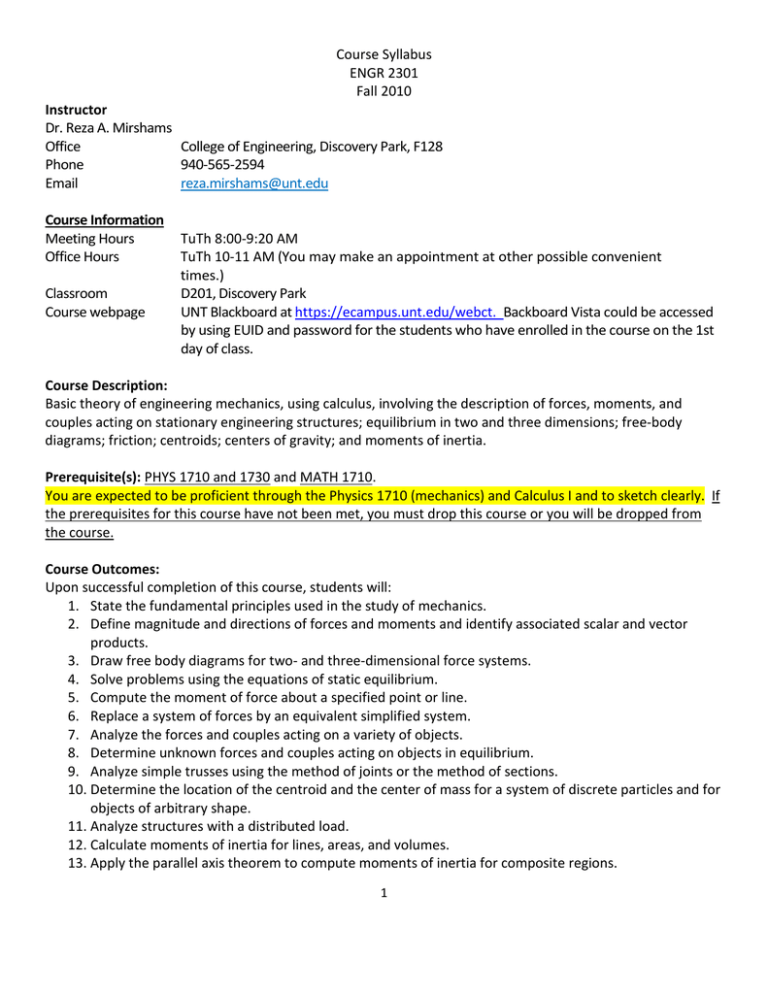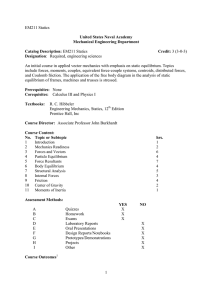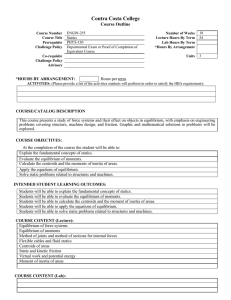
Course Syllabus
ENGR 2301
Fall 2010
Instructor
Dr. Reza A. Mirshams
Office
College of Engineering, Discovery Park, F128
Phone
940-565-2594
Email
reza.mirshams@unt.edu
Course Information
Meeting Hours
Office Hours
Classroom
Course webpage
TuTh 8:00-9:20 AM
TuTh 10-11 AM (You may make an appointment at other possible convenient
times.)
D201, Discovery Park
UNT Blackboard at https://ecampus.unt.edu/webct. Backboard Vista could be accessed
by using EUID and password for the students who have enrolled in the course on the 1st
day of class.
Course Description:
Basic theory of engineering mechanics, using calculus, involving the description of forces, moments, and
couples acting on stationary engineering structures; equilibrium in two and three dimensions; free-body
diagrams; friction; centroids; centers of gravity; and moments of inertia.
Prerequisite(s): PHYS 1710 and 1730 and MATH 1710.
You are expected to be proficient through the Physics 1710 (mechanics) and Calculus I and to sketch clearly. If
the prerequisites for this course have not been met, you must drop this course or you will be dropped from
the course.
Course Outcomes:
Upon successful completion of this course, students will:
1. State the fundamental principles used in the study of mechanics.
2. Define magnitude and directions of forces and moments and identify associated scalar and vector
products.
3. Draw free body diagrams for two- and three-dimensional force systems.
4. Solve problems using the equations of static equilibrium.
5. Compute the moment of force about a specified point or line.
6. Replace a system of forces by an equivalent simplified system.
7. Analyze the forces and couples acting on a variety of objects.
8. Determine unknown forces and couples acting on objects in equilibrium.
9. Analyze simple trusses using the method of joints or the method of sections.
10. Determine the location of the centroid and the center of mass for a system of discrete particles and for
objects of arbitrary shape.
11. Analyze structures with a distributed load.
12. Calculate moments of inertia for lines, areas, and volumes.
13. Apply the parallel axis theorem to compute moments of inertia for composite regions.
1
14. Solve problems involving equilibrium of rigid bodies subjected to a system of forces and moments that
include friction.
15. Solve problems involving dry sliding friction, including problems with wedges and belts.
Required Textbook:
Engineering Mechanics, STATICS, 12th Edition, author: R.C. Hibbeler, Publisher Prentice Hall Pearson,
www.pearsonhighered.com.
It is required to have one of the following versions of textbook with access to MasteringEngineering website:
• Hibbeler Statics, 12E with MasteringEngineering: (ISBN 0137031939)
• MasteringEngineering Statics Standalone w/e-text: (ISBN 0136116590)
• MasteringEngineering Statics standalone w/o e-text: (ISBN 0132462311)
Grading:
Two class exams (25% each, 1.5 hour, no drops)
Online Homework and tutorial
In class quizzes and hand written homework (2 drops)
Final Exam (Comprehensive)
50% (September 30 and November 2)
10%
15%
25% (December 16, 8:00-10:00 AM)
Grade Distribution
A ≥ 90%, B ≥ 75%, C ≥ 65%, D ≥ 55%, F below 55%
Course Instruction and Assignments
1. Backboard Vista, at http://ecampus.unt.edu, will be used for posting the course materials and instructions,
assignments, submission of assignments, email communications about the course, and the course gradebook.
2. Required homework assignments and online tutorial from the textbook will be on MasteringEngineering,
the Pearson Prentice Hall online tutorial and homework system at
http://www.masteringengineering.com. The course access code ID is MIRSHAMS2301F2010.
3. Each week one hand-written problem solution is required.
• The hand-written homework must be turned in at the beginning of class.
• Late homework submittals will not be accepted without prior authorization.
• Write on one side of page only.
• Submitted work must be legible and presented in a logical, easy-to-follow manner or it will be graded as
zero. Model solutions will be shown in the class.
4. Discussion and exchange of ideas are important parts of the learning process and I encourage
collaboration in a community of scholars. However, you must be sure the work you submit for grading is
your own. Submitted works that are copies from solution manuals or website solutions or your
classmates will be treated as plagiarism.
5. Be sure to check Blackboard Vista and the course email at least every other day, if not daily. All
communications related the course will be made through the Blackboard site.
6. Attendance is required for all class hours.
7. No make-up on quizzes and homework assignments.
8. No make-up will be given for the scheduled exams, unless the student has a legitimate excuse documentation
properly (e.g., letter from court clerk that he/she must appear in a court, letter from physician that
2
he/she is sick, etc.) then your score on the final exam will be substituted for the missed exam score;
otherwise, the missed exam will be scored as 0. Only one such substitution is permitted during the
semester.
Exams and Quizzes
Class exams and quizzes are written and closed textbook and notebooks. You will be allowed to bring one
double-sided page with hand-written notes and formulae for the exams only. Please write your name on the
top right corner of your sheet. It will not be allowed to share your formula sheet with others during the exam.
It will be helpful to bring a ruler for solving graphical problems. It will not been allowed to use a laptop or an
iPhone or any other handheld computers and cell phones during the exams and quizzes. Of course, you are
allowed to bring a scientific/engineering calculator. However, sharing calculators during the exams will not be
permitted.
Grades are based in part on the student's ability to communicate. You must present your entire solution in an
orderly way for each problem. Grade points will not be assigned only on the final answers. You must show
complete process of your solution. Partial credits will be assigned for correct steps have been taken in a
solution.
Requests for the review of a graded exam problem must be submitted in writing no later than the next class
day following the return of a graded exam. The graded exam should be attached to your request and you must
explain your reason for requesting a grade review. In this matter, the review is not limited to a single problem
requested by the student. Upon review, the exam score may increase, remain the same, or decrease.
An I (incomplete) grade is given only for extenuating circumstances and in accordance with University and
Departmental Policies.
Disabilities Accommodation:
The University of North Texas complies with Section 504 of the 1973 Rehabilitation Act and with the
Americans with Disabilities Act of 1990. The University of North Texas provides academic adjustments and
auxiliary aids to individuals with disabilities, as defined under the law. Among other things, this legislation
requires that all students with disabilities be guaranteed a learning environment that provides for reasonable
accommodation of their disabilities. If you believe you have a disability requiring accommodation, please see
the instructor and/or contact the Office of Disability Accommodation at 940-565-4323 during the first week of
class.
Additional Class Policies
1. The Student Evaluation of Teaching Effectiveness (SETE) is a requirement for all organized classes at
UNT. This short survey will be made available to you at the end of the semester, providing you a
chance to comment on how this class is taught. I am very interested in the feedback I get from
students, as I work to continually improve my teaching. I consider the SETE to be an important part of
your participation in this class.
2. The UNT Catalog procedures on cheating and plagiarism will be vigorously enforced. It is the duty of
each student to protect their work so it is not available to others for submission as their efforts. This is
especially true of files that are generated on the computer. Students that knowingly allow others to
3
use their work are partners in this unethical behavior. All rules relating to academic dishonesty will be
enforced in accordance with University policies.
3. State common law and federal copyright laws protect this course lectures and materials. They have my
own original expression and revisions to the textbook author(s) and I record them at the same time
that I deliver them in order. Whereas you are authorized to take notes in class, thereby creating a
derivative work from my lecture, and/or make a print of my lecture notes/slides. The authorization
extends only to making one set of notes for your own personal use and no other use. You are not
authorized to record my lectures, to provide your notes to anyone else or to make any commercial use
of them without express prior permission from me.
4. This syllabus is subject to change at any time during the semester with changes to be announced
during the class hours.
5. Cell phones, iPhones, iPods, iPads, laptops must be turned off or in silent mode before the start of the
class and left in your pocket, purse, or book bag.
Course Schedule may be adjusted during the semester.
Each class meeting may have a mix of lecture, hands-on problem solving, review of homework problems
and pop quiz.
TOPIC
TEXTBOOK
CHAPTER
Class Meeting 1
August 26, 2010
Introduction
Class Meeting 2
Fundamental of Engineering Mechanics and Procedure of Problem
Solving
1
Class Meeting 3
Application of Vector Analysis.
2
Class Meeting 4
Cartesian Vectors
2
Class Meeting 5
Position vectors and Force Vectors Dot Products
2
Class Meeting 6
Equilibrium of a Particle
3.1-3.2
Class Meeting 7
Equilibrium of a Particle
3.3
Class Meeting 8
Equilibrium of a Particle
3.4
Class Meeting 9
Moment of a force and Vector Formulation
4.1-4.3
Class Meeting 10
Principle of Moments about a point and Review for Exam I
4.4
4
Class Meeting 11
September 30, 2010
Class Meeting 12
Exam I
Moments about an Axis
4
Class Meeting 13
Moment of a Couple
4.5-4.6
Class Meeting 14
Force System Resultant
4.7-4.9
Class Meeting 15
Equilibrium of a Rigid Body
5.1-5.3
Class Meeting 16
Equilibrium of a Rigid Body
5.4-5.5
Class Meeting 17
Equilibrium of a Rigid Body
5.6-5.7
Class Meeting 18
Class Meeting 19
Class Meeting 20
November 2, 2010
Class Meeting 21
Class Meeting 22
Class Meeting 23
Class Meeting 24
Structural Analysis I
Structural Analysis I and Review for Exam II
Exam II
6.1-6.3
Structural Analysis II
Fames and Machines
Fames and Machines
Internal Forces
6.3-6.5
6.6
6.6
7.1
Class Meeting 25
Class Meeting 26
Class Meeting 27
Class Meeting 28
Class Meeting 29
Class Meeting 30
Friction
Friction
Center of Gravity and Centroid
Center of Gravity and Centroid
Moment of Inertia
Moment of Inertia
8.1-8.2
8.3-8.4
9.1-9.2
9.3
10.1-10.3
10.4
Class Meeting 31
Class Meeting 32
December 16, 2010
Review for final exam
Final Exam
5




